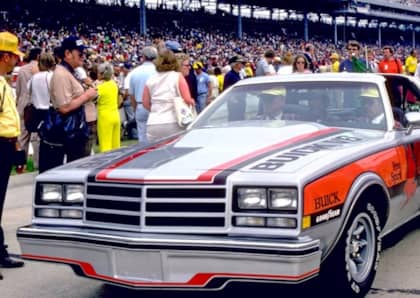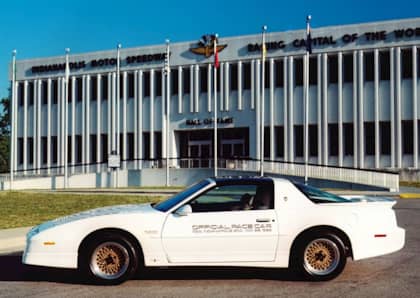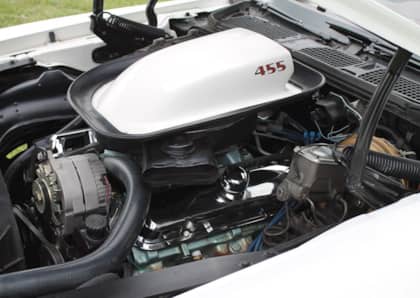GM's G-Body Cars Offer Rear Wheel Drive Muscle And Luxury For '80s Era Collectors
The 1980s marked the transition from rear-wheel drive to front-wheel drive for the majority of the passenger car market. Over the course of the decade, almost every mainstream sedan, coupe, and wagon would trade a driven rear axle for the space-saving, inexpensive, and somewhat more efficient promise of a front-puller setup.

Of course, there were a few hold-outs—many performance cars retained their original drivetrain layout, and so did most luxury models—but by and large the die was cast and front-wheel drive was primed to take over the market.

One of the last remnants of rear-wheel drive at General Motor was the G-body, a vehicle platform that had appeared at the end of the 1970s as a reaction to the excesses of that decade. Smaller than the land whales that had preceded it, the G-body from Chevrolet, Pontiac, Oldsmobile, and Buick, promised to balance lighter designs with respectable comfort and a dash of performance. Along the way, it spawned a legend, flirted with aerodynamic experimentation, and claimed the title of Detroit's last traditional body-on-frame daily driver offered outside of the full-size segment.

Today, the G-body—particularly the coupe version—is an overlooked entry point into the classic car world, and with more than 10 million sold they have stayed affordable. Available with both small block V8 engines as well as turbocharged V6s, the G-body has performance potential and a touch of class that help to set it apart from other Rad-era rides.
Smaller, Better, Lighter
The G-body arrived on the scene in 1978, and its 108-inch wheelbase made it smaller than even the compact GM models that were sold alongside it until 1980. It was the platform's modest, yet still usable proportions that made it such a versatile option for a wide range of buyers, as the G-body could be found in wagon, sedan, and coupe versions that fit almost any price point.

Chevy's G-body contributions were represented by the Monte Carlo personal luxury coupe and the Malibu, which was available in three different body styles. Buick had the Regal and the Century, Oldsmobile provided the Cutlass (Supreme and Cruiser), while Pontiac started out with the Grand Prix (coupe-only like the Monte Carlo) the LeMans (only until 1981) and the Bonneville (as a sedan).

There were a couple of unusual models too, like the Chevrolet El Camino and the GMC Caballero 'utes that were built on the G-body platform.

From the outset, power was modest, which wasn't a bad match for the G-body's 3,000 or so pounds of curb weight. Most models made do with a V6 (ranging from 3.2L up to the vaunted 3.8L that would come to dominate GM's line-up), with a few other oddballs in the mix. General Motors had yet to streamline its engine production, so individual brands were still producing their own similarly-sized, but ultimately differently-designed power plants in-house. Transmissions were largely limited to three and four-speed automatics.

Chevrolet offered a 305 cubic inch V8 in the Malibu (topping out around 170 horsepower), while the Monte Carlo eventually snagged a 180 horsepower version of the same motor. Pontiac provided a 301 that was good for about 150 horses, although California residents saw a 305 swapped in its place, and Oldsmobile's 307 cubic incher was in roughly the same ballpark. A very limited diesel engine was also offered across the G-body family, but this diesels were the black sheep of the GM portfolio and were soon avoided by customers leery of their poor reputation for reliability.
Icons And Outliers
Factory performance models were of course offered over and above the standard drivetrains, and there were some unique choices to be had during the G-body's heyday.

Of these, the most famous is the Buick Regal's extensive line of turbocharged V6 choices, marketed as the T-Type, the Grand National and the GNX. The latter would reach 276 horsepower and 360 lb-ft of torque when it hit the market in 1987, capping off the final year of production for almost every G-body (which were gradually being replaced by the front-wheel drive A-body, which the Century had already transitioned to several years beforehand).

The Grand National and the GNX provided an unlikely competitor for other '80s performance cars like the Ford Mustang GT and the Chevrolet Camaro. In fact, the GNX was so quick that it threatened the Chevrolet Corvette's position at the top of the GM pyramid, as it boasted quicker acceleration and a higher top speed.

Chevrolet ended up briefly borrowing a version of Buick's 3.8-liter turbocharged V6 for the Monte Carlo, offering a 170 horsepower Turbo model in 1981. Following that, the Monte Carlo was offered in SS form (with an extended front clip and a number of appearance and suspension upgrades) as well as the Aerocoupe that delivered unique rear glass that tapered toward the trunk as part of a limited NASCAR homologation project (Oldsmobile, Buick, and Pontiac ran standard G-body coupes stock car racing as well).

Pontiac also offered an Aerocoupe Grand Prix, although it was dubbed the '2+2.' Just over 6,000 Aerocoupes were sold, complemented by about 1,000 or so 2+2s.

Oldsmobile delivered a pair of hi-po G-bodies that traded on its heritage, starting with the Hurst/Olds that married a 307 cubic inch V8 with T-tops, more aggressive gearing, and the puzzlingly complex 'lightning rods' shifter system for the automatic transmission. The vehicle was built for the 1983 and 1984 model years. From 1985 (until the Cutlass departed for the A-body platform after 1987), the Hurst/Olds was replaced by the 442, which was largely a styling package with mild suspension upgrades and a 170-180 horsepower version of the 307 cubic inch V8.
A Blank Canvas
With such mild performance for their era, the true appeal of the G-body for today's collector lies in their ease of modification. Any small block Chevrolet engine will fit inside the engine bay of the Pontiac, Chevy, Oldsmobile, and Buick models listed above, which means the sky is the limit when it comes to boosting output for straight line speed. An LS swap is another easy fit (although considerably more complex when it comes to wiring and computer controls).

Of course, Buick fans are more likely to snag either a Grand National or a T-Type and make the required modifications to bring its version of the 3.8-liter turbocharged V6 into GNX territory.

Either way, there's no denying that that coupes in particular cut a stylish profile from a time when boxy was the order of the day. Throw in the wagon cult that has sprung up around the most practical versions of the G-body, across-the-board parts swapping capability, and the support for this platform from both the aftermarket and brand experts keeping the faith in garages across the country is phenomenal.











